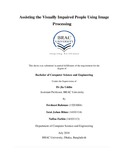| dc.contributor.advisor | Uddin, Jia | |
| dc.contributor.author | Rahman, Ferdousi | |
| dc.contributor.author | Ritun, Israt Jahan | |
| dc.contributor.author | Farhin, Nafisa | |
| dc.date.accessioned | 2018-12-03T08:49:25Z | |
| dc.date.available | 2018-12-03T08:49:25Z | |
| dc.date.copyright | 2018 | |
| dc.date.issued | 2018-07 | |
| dc.identifier.other | ID 15201004 | |
| dc.identifier.other | ID 14101114 | |
| dc.identifier.other | ID 14101113 | |
| dc.identifier.uri | http://hdl.handle.net/10361/10949 | |
| dc.description | This thesis is submitted in partial fulfilment of the requirements for the degree of Bachelor of Science in Computer Science and Engineering, 2018. | en_US |
| dc.description | Cataloged from PDF version of thesis. | |
| dc.description | Includes bibliographical references (pages 38-41). | |
| dc.description.abstract | Visually impaired people face difficulties in safe and independent movement which deprive them from regular professional and social activities in both indoors and outdoors. Similarly they have distress in identification of surrounding environment fundamentals. The proposed thesis suggests of detection of brightness and the major colors in real-time image by using RGB method by means of an external camera and thus identification of fundamental objects as well as facial recognition from personal dataset. For the Object identification and Facial Recognition, YOLO Algorithm and MTCNN Networking are used respectively. The software support is achieved by using OpenCV libraries of Python as well as implementing machine learning process. The major processor of our thesis, Raspberry Pi scans and detects the facial edges via Pi camera and objects in the image are captured and recognized using mobile camera. Image recognition results are transferred to the blind users by means of text-to-speech library. The device portability is achieved by using a battery. The object detection process achieved 8-15 FPS processing with an accuracy rate of 63-80%. The face identification process achieved 80-100% accuracy. The objective of the thesis is to give blind users the capability to move around in unfamiliar indoor environment, through a user friendly device by face and object identification system. | en_US |
| dc.description.statementofresponsibility | Ferdousi Rahman | |
| dc.description.statementofresponsibility | Israt Jahan Ritun | |
| dc.description.statementofresponsibility | Nafisa Farhin | |
| dc.format.extent | 41 pages | |
| dc.language.iso | en | en_US |
| dc.publisher | BRAC University | en_US |
| dc.rights | BRAC University theses are protected by copyright. They may be viewed from this source for any purpose, but reproduction or distribution in any format is prohibited without written permission. | |
| dc.subject | Visually impaired | en_US |
| dc.subject | OpenCV | en_US |
| dc.subject | Image processing | en_US |
| dc.subject | Object detection | en_US |
| dc.subject | Face detection | en_US |
| dc.subject | YOLO algorithm | en_US |
| dc.subject | Deep learning | en_US |
| dc.subject.lcsh | Image processing | |
| dc.subject.lcsh | Computer network architectures. | |
| dc.subject.lcsh | Computer algorithms. | |
| dc.title | Assisting the visually impaired people using image processing | en_US |
| dc.type | Thesis | en_US |
| dc.contributor.department | Department of Computer Science and Engineering, BRAC University | |
| dc.description.degree | B. Computer Science and Engineering | |

